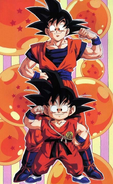| This page uses content from the English Wikipedia. The original article was at Son Goku.
The list of authors can be seen in the page history. |
Son Goku/Sun Wukong (孫悟空 Son Gokū) is the main protagonist of the Dragon Ball manga series. He is both directly named after and is an alternate take on the character of the same name from the classic Chinese novel Journey to the West (as his name is a Chinese name written in Japanese on'yomi). Goku is introduced in Dragon Ball chapter #1 Bulma and Son Goku (ブルマと孫悟空 Buruma to Son Gokū), originally published in Japan's Weekly Shonen Jump magazine on December 3, 1984,[1] as an eccentric, monkey-tailed boy who practices martial arts and possesses superhuman strength. He meets Bulma and joins her on a journey to find the wish-granting Dragon Balls.
Initially believed to be an Earthling, he is later revealed to be a member of an extraterrestrial warrior race called the Saiyans with the birth name Kakarot (カカロット Kakarotto). As Goku grows up, he becomes the Earth's mightiest warrior and protects his adopted home planet from those who seek to harm it.
Appearance[]
Goku has spiky black hair that never changes throughout the franchise (except when in his various Super Saiyan forms). He is most commonly seen wearing his trademark Turtle School uniform over a dark blue short-sleeved undershirt. This gi has featured either Master Roshi's, King Kai's, or Goku's own kanji on its back, as well as Roshi's or Goku's kanji on the front-left side (around the stomach-area). Between the Frieza Saga and Battle of Gods Saga, Goku doesn't wear any kanji on his gi, but he retains the dark blue undershirt. He also wears dark blue wristbands, along with dark blue boots with a yellow border (later red) that are outfitted with red laces (later yellowish-brown). He originally wore a blue obi tied in a knot over his waist, although after the Frieza Saga this was changed to a blue sash.
In the beginning of Dragon Ball, Goku is introduced wearing a blue gi with red wristbands, a white obi tied in a bow over his waist and dark blue kung fu shoes. As a kid, he also wields the Power Pole and has a tail due to his Saiyan heritage. Beginning with the 21st World Martial Arts Tournament and for the majority of Dragon Ball, Goku wears the basic Turtle School gi as his main outfit until after his training with Kami and Mr. Popo. At the 23rd World Tournament and for the remainder of Dragon Ball, Goku has his tail permanently removed by Kami (through unknown means) and wears an updated Turtle School gi that features the same short-sleeved undershirt and boots that become part of his signature outfit throughout Dragon Ball Z. At the very end of Dragon Ball Z, Goku wears a turquoise gi with a white obi, orange wristbands, dark green pants, and black kung fu shoes with orange stockings.
In Dragon Ball Super, Goku alternates between wearing his signature orange and blue dōgi with his own kanji again, and a new dōgi uniform consisting of an orange fold-over shirt and matching pants with blue wristbands, blue boots and a blue belt tied in a knot at his side (which debuted in the film Resurrection 'F); given to him by his new teacher Whis.
Abilities[]
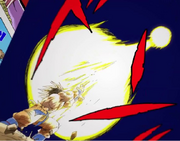
Goku preforming his signature technique: the Kamehameha.
Goku's skills as a warrior largely exceeds that of a human and his Saiyan race, gaining him the title of Earth's mightiest warrior. Goku is known for his incredible physical strength. While training, Goku pushes his body to the absolute limit. He has been shown to lift four tons in a ten times Earth's gravity environment. Goku is also known for his superhuman speed which he can use to catch bullets faster than the naked eye. He also has immense durability and high senses. Like all Z-Fighters, Goku is capable of flight and preforming ki. Goku's signature energy wave is his iconic Kamehameha (かめはめ波 Turtle Devastation Wave).
- Transformation: Because of his Saiyan heritage, Goku can achieve a transformation that multiplies his Saiyan's power level called a Super Saiyan (超サイヤ人 Sūpā Saiya-jin). The most noticeable physical change is that Goku's hair becomes golden blonde in color and stands on end, giving it a rising, flame-like appearance, including his eyebrows. His natural eye color temporarily changes to a greenish-blue, muscle tone becomes more defined, and his skin tone (and clothing) becomes lighter. Goku can also ascend to greater levels called Super Saiyan 2 (超サイヤ人 ツー Sūpā Saiya-jin Tsū) and Super Saiyan 3 (超サイヤ人 スリー Sūpā Saiya-jin Surī). In Super Saiyan 2, Goku's strength doubles and becomes much stronger than the regular Super Saiyan transformation. Goku's golden hair also becomes longer and rigid and stands up even more. In Super Saiyan 3, Goku's speed, strength and endurance are all pushed far beyond the normal limits than when he is transformed into a Super Saiyan 2. The major physical change Super Saiyan 3 causes is Goku's golden hair growing all the way down to his waist and his eyebrows vanish completely.
Years later, Goku obtained a stronger form that surpasses his Super Saiyan transformations called Super Saiyan God (超サイヤ人ゴッド Sūpā Saiya-jin Goddo). In this transformation, Goku possesses godly ki and allows him to battle powerful gods such as Beerus. In this transformation, Goku's appearance does not change drastically with the exception of becoming thinner and his hair becomes red. Goku also gained a stronger form, known as Super Saiyan God Super Saiyan (超サイヤ人ゴッド超サイヤ人 Sūpā Saiya-jin Goddo Sūpā Saiya-jin) or Super Saiyan Blue (超サイヤ人ブルー Sūpā Saiya-jin Burū), where he is able to use his God power with Super Saiyan. This transformation is identical to the Super Saiyan transformation with the only difference being his hair becoming light blue instead of golden blonde.
Even further, he would later obtain the form known as Ultra Instinct, however it was initially incomplete and therefore called Ultra Instinct Omen, which made his hair slightly spikier and gained silver iris's. He would later obtain the complete ultra instinct, allowing him to best jiren, along with turning his hair silver. After learning about Saiyan Pride he could now use his emotions while in ultra instinct, evolving it into True Ultra Insinct, identical to Omen but far more powerful.
Former Abilities[]
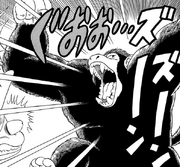
Goku as a Great Ape.
As a Saiyan, Goku is capable of transforming into a Great Ape when he looks directly at a full moon but needs his tail to do so. When he transforms, Goku loses all sense of himself and destroys everything that he sees or anything that may harm him. By the time Goku is introduced as a young adult during the 23rd World Martial Arts Tournament, his tail is removed after Kami offered to restore the moon in exchange for his tail.
Creation and Conception[]
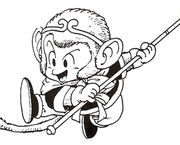
Akira Toriyama's first draft of Goku
Goku, and Dragon Ball in general, evolved from one of Akira Toriyama's earlier one-shot series called Dragon Boy. When Toriyama created Dragon Ball, he was inspired by Journey to the West.[2] Goku's design was based on Tanton, of Akira Toriyama's prototype manga Dragon Boy and Tongpoo, from his other manga The Adventures of Tongpoo. When Toriyama started his first draft of Dragon Ball, he originally planned on making Goku full monkey to make the series more faithful to Journey to the West. During Toriyama's second draft, he wanted to make Goku a full human dressed in sailor clothes that rode a flight mecha instead of the Flying Nimbus.[3] Toriyama's third and final draft of Goku was to have him human looking with a monkey tail.
To be creative with the idea of Sun Wukong, Toriyama designed Goku as a human boy with a monkey's tail, rather than a complete simian, because the tail would give the character a distinguishing feature.[4] He later stated that the tail was a pain to draw, hence why he had it get cut off early on.[5] Toriyama did not initially plan to make Goku an alien, it was not until the introduction of fighters from other planets that he established him as a Saiyan.[6] Goku was given the ability to teleport to any planet in seconds, so that Toriyama could increase the pace of the story.[7]
Wanting Dragon Ball to have a Chinese appearance, Toriyama used the color of the robes worn by Buddhist monks for Goku's dōgi.[8] During the early chapters of the manga, Toriyama's editor, Kazuhiko Torishima, commented that Goku looked rather plain. Toriyama had given him simple clothes on purpose because it was a fighting manga, so to combat this he added several characters like Kame-Sen'nin and Kuririn, and created the Tenkaichi Budōkai to focus the storyline on fighting. To defy the assumption that Goku would win the tournaments, Toriyama made him lose the first and second but win the third.[4] Toriyama also mentioned Torishima wanted Goku to form a relationship with Bulma but this was never applied to the series.[9]
Toriyama's editor was initially against having Goku grow up, saying it was uncommon to have the protagonist drastically change in manga, however, he gave in when Toriyama threatened that he would not be able to continue the series if the character did not.[10] Toriyama later stated he had him grow up as a means to make drawing the fight scenes easier.[11] When Toriyama thought up the Super Saiyan concept, he felt the only way to show Goku's massive power up was to have him transform. Initially he was concerned that the facial expression looked like that of a villain, but felt that since the transformation was brought about by anger it was acceptable.[12] With the conclusion of the Cell arc, Gohan was intended to replace his father as protagonist, but Toriyama decided that Gohan was unsuitable for the role.[4]
Dragon Ball GT chief character designer Katsuyoshi Nakatsuru said he agonized over designing Super Saiyan 4 Goku, which was the idea of the show's producers, questioning whether it was necessary to go further with the transformations. Because Super Saiyan 4 is brought about while in a Saiyan's Ōzaru ("Great Ape") form, he made the hair more "wild" and covered Goku's body in red fur. There was only a single final draft of the character, although Nakatsuru did consider making the hair blonde, he ended up choosing black as it provides more contrast with the red fur.[13]
Voice actors[]
In the Japanese version of every Dragon Ball anime series and subsequent related media, Goku has been voiced by Masako Nozawa. Toriyama selected Nozawa upon hearing her audition sample, remarking that only Goku could sound like that.[14] Nozawa stated that she was ecstatic when she got the role because she had always wanted to be in one of Toriyama's works. She said she had to be mindful of the fact that Goku grew up in the mountains and did not know much of the world. Despite having to voice Goku, Gohan, Goten and Bardock, Nozawa claims she is able to instantly get into the respective character simply upon seeing their image.[15] Nozawa explained that she did not read the manga so that she would not know what was coming in the story until recording, making her reactions the same as Goku's.[16] In most non-Japanese versions, different voice actors have been used for the child and adult forms of the character. In the numerous English versions, Goku has been played by different actors because different companies produced the dubs, by reason of changes of ADR companies and recording studios, or due to actors quitting.
As a child, Goku has been voiced by Barbara Goodson in Harmony Gold's very brief English dub of Dragon Ball (in which Goku was renamed "Zero");[17] by Saffron Henderson in Funimation's original dub of the first 13 episodes of Dragon Ball and the movie Curse of the Blood Rubies (produced in association with BLT Productions);[18] by Brianne Siddall in Bandai's English release of the video game Final Bout;[19] by Zoe Slusar in AB Groupe's dub of Dragon Ball and Dragon Ball GT (produced in association with Blue Water Studios) for Canadian and European broadcast;[20] and by Ceyli Delgadillo (Sleeping Princess in Devil's Castle, Mystical Adventure), Stephanie Nadolny (Dragon Ball, Dragon Ball GT, The Path to Power, video games) and Colleen Clinkenbeard (Curse of the Blood Rubies, XenoVerse, XenoVerse 2) in Funimation's in-house dub of the entire Dragon Ball franchise in the United States.[18]
As an adult, Goku has been voiced by Ian James Corlett and Peter Kelamis in Funimation's original dub of the first 67 episodes of Dragon Ball Z (edited into 53 episodes; produced in association with Saban and Ocean Productions), and the movies Dead Zone, The World's Strongest and The Tree of Might;[18][21] by Steven Blum in Bandai's English release of the video game Final Bout;[19] by Peter Kelamis and Kirby Morrow in AB Groupe's dub of episodes 123-291 of Dragon Ball Z (produced in association with Westwood Media and Ocean Productions) for European and Canadian broadcast;[22] by Jeffrey Watson and Jeremiah Yurk in AB Groupe's dub of Dragon Ball and Dragon Ball GT (produced in association with Blue Water Studios) for Canadian and European broadcast;[20] and consistently by Sean Schemmel in Funimation's in-house dub of the entire Dragon Ball franchise in the United States.[23]
The voices of AB Groupe's dub of various Dragon Ball and Dragon Ball Z movies (also known as the "Big Green" dub) distributed only in Europe had been left unknown for many years, but now it is believed that David Gasman has voiced Goku as an adult, while his voice as a child was provided by Jodi Forrest.[24] Goku is also voiced by Andrea Kwan (child) and Dave Bridges (adult) for Animax Asia. Nesty Calvo Ramirez provided his voice in an English dub distributed exclusively in the Philippines by Creative Products Corporation.
In the Japanese dub of the live-action film Dragonball Evolution, Goku is voiced by Kappei Yamaguchi.
Other Media[]
As the protagonist, Goku appears in most of the episodes, films, television specials and OVAs of the manga's anime adaptations (Dragon Ball, Dragon Ball Z, Dragon Ball GT and Dragon Ball Super), as well as many of the franchise's video games.
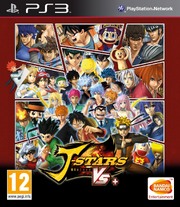
J-Stars Vs.
Goku has appeared in an unofficial Taiwanese live-action film[25] and an unofficial Korean live-action film.[26] He was portrayed by Justin Chatwin in the 2009 20th Century Fox feature Dragonball Evolution.[27] Goku has also appeared in almost every Dragon Ball licensed electronic video game, including crossover games such as Jump Super Stars, Jump Ultimate Stars, Battle Stadium D.O.N, and J-Stars Victory Vs. In 1992, Goku was featured in the interactive game Dragon Ball Z: Get Together! Goku World,[28] in which Goku and his gang travel back in time to review events in the Dragon Ball timeline and interacts with his younger self. In December 2007, Goku made a guest appearance in avatar form in the MMORPG Second Life for a Jump Festa promotion titled Jumpland@Second Life.[29] Goku also appears in the Dr. Slump and Arale-chan video game for the Nintendo DS.[30]
Goku has been the subject of, and is mentioned in, various songs. "Son Goku Song"[31] and "Gokū no Gokigen Jānī"[32] feature Goku as a child singing about himself. During his adult years, the song "Aitsu wa Son Gokū" by Hironobu Kageyama, where Kageyama praises everything about Goku,[33] and the duet "Ore-tachi no Energy"[34] feature words spoken by the character. For the release of the single of the Dragonball Evolution international theme song "Rule", Toriyama supplied CD artwork of singer Ayumi Hamasaki dressed as Goku.[35]
Goku has been used in Japanese public service announcements aimed at children. In June 1988, Goku and other Dragon Ball characters were featured in two PSA short films. The first, in which Goku is taught the importance of obeying traffic safety by others, is entitled The Goku Traffic Safety (悟空の交通安全 Gokū no Kōtsū Anzen).[36] The second is called The Goku Fire Fighting Regiment (悟空の消防隊 Gokū no Shōbō-tai), in which he teaches two children the importance of fire safety.[36]
Goku has made guest appearances in various Japanese television shows and manga. In 2005, Goku appeared in the Toriyama parody manga Neko Majin Z where he is the sensei of the main character Z.[37] On September 15, 2006, in celebration of the 30th anniversary of Kochira Katsushika-ku Kameari Kōen-mae Hashutsujo, the special manga Super Kochikame (超こち亀 Chō Kochikame) was released. The chapter entitled This is the Police Station in front of Dragon Park on Planet Namek (こちらナメック星ドラゴン公園前派出所 Kochira Namekku-sei Dragon Kōen-mae Hashutsujo) has Ryotsu Kankichi travel to planet Namek and try to issue Freeza a citation and scold he and Goku for parking their ships illegally.[38] Goku and other Dragon Ball characters join the cast of One Piece in the 2006 crossover manga Cross Epoch.[39] He also appears in a single panel of Toriyama's 2013 manga Jaco the Galactic Patrolman, which is set before the events of Dragon Ball.[40] The collected tankōbon volume of Jaco features the bonus story Dragon Ball Minus: The Departure of the Fated Child, depicting how and why Goku's father and mother, Gine (ギネ), sent him to Earth.[41][42]
Goku has been the subject of various parodies. In the episode Career Day of Takeshi's Castle, known in the United States as MXC, the hosts Beat Takeshi and Sonomanma Higashi dressed as popular anime characters, one as Goku as a child, the other as Doraemon.[43] Weekly Shōnen Jump's Gag Special 2005 issue, released on November 12, 2004, featured a Bobobo-bo Bo-bobo one-shot Dragon Ball parody manga, a retelling of the first fight between Goku and Vegeta.[44] In chapter #179 of the Yakitate!! Japan manga, Kawachi executes a Genki-Dama parody called a Shinrai-Dama (信頼玉, lit. "Trust Ball") on the character Katsuo.[45]

Goku's appearance as a commentator at the 2007 Nippon Ijin Taishō.
Goku regularly appears on Fuji TV. In 2003, Goku appeared in the interactive feature Kyutai Panic Adventure! (球体パニックアドベンチャー! Kyūtai Panikku Adobenchā!, "Orb Panic Adventure!"), which was featured exclusively at the Fuji TV headquarters in the Kyutai (orb) section. In this, Freeza attacks a visiting tourist, blasting the orb section free from the rest of the Fuji TV building. Goku fights Freeza over the real life aqua city of Odaiba.[46][47] In 2004, a sequel called Kyūtai Panic Adventure Returns! (球体パニックアドベンチャーリターンズ! Kyūtai Panikku Adobenchā Ritānzu!, "Orb Panic Adventure Returns!") was produced.[48] On March 25, 2006, Goku and Freeza appeared in an original animated short film in the IQ Mirror Mistake 7 (IQミラーまちがい7 Aikyū Mirā Machigai Nana) segment of the Japanese game show IQ Supplement (IQサプリ IQ Sapuri).[49] On April 7, 2007, Goku and Fuji TV announcer Masaharu Miyake were commentators on the anime segment in the Nippon Ijin Taishō (日本偉人大賞, "Japan Great Man Awards") titled Saikyō no Ijin ha Dare? (最強の偉人は誰?, "Who is the Strongest Hero?"). The segment featured a special tournament to decide who was the greatest person in Japanese history. During the intermission, Goku promoted the coming release of R2 Dragon Ball DVDs.[50]
Cultural References[]
- Main article: Son Goku/Cultural References
Goku has also influenced several other works of fiction.
Gallery[]
References[]
- ↑ Weekly Shonen Jump #51 December 3, 1984
- ↑ Template:Cite book
- ↑ Cite error: Invalid
<ref>tag; no text was provided for refs namedDaiz2 - ↑ 4.0 4.1 4.2 Template:Cite book
- ↑ Template:Cite book
- ↑ Template:Cite book
- ↑ Template:Cite book
- ↑ Template:Cite book
- ↑ Toriyama, Akira (1986). Dr. Slump, Volume 16. Viz Media. p. 130. ISBN 978-1-4215-1060-6.
- ↑ Template:Cite journal
- ↑ Template:Cite book
- ↑ Template:Cite book
- ↑ Template:Cite book
- ↑ Template:Cite book
- ↑ Template:Cite book
- ↑ Template:Cite book
- ↑ Dragon Ball Harmony Gold dub's credits
- ↑ 18.0 18.1 18.2 Dragon Ball Funimation dub's credits
- ↑ 19.0 19.1 Dragon Ball GT: Final Bout credits
- ↑ 20.0 20.1 Dragon Ball and Dragon Ball GT AB Groupe dub's credits
- ↑ "Interview With Ian Corlett". www.animecauldron.com. Retrieved April 30, 2015.
- ↑ Dragon Ball Z AB Groupe dub's credits
- ↑ Dragon Ball, Dragon Ball Z, Dragon Ball GT, and Dragon Ball Z Kai Funimation dub's credits
- ↑ http://www.behindthevoiceactors.com/forums/showthread.php?t=15614
- ↑ Template:Cite AV media notes
- ↑ Template:Cite AV media notes
- ↑ Tatiana Siegel (November 13, 2007). "'Dragonball' comes to bigscreen". Variety. Retrieved November 14, 2007. Italic or bold markup not allowed in:
|publisher=(help) - ↑ Template:Cite video game
- ↑ "Dragon Ball, Naruto, One Piece to Enter Second Life". Anime News Network. December 21, 2007. Retrieved November 3, 2008.
- ↑ "Dr Slump Arale-chan feat Son Goku Kid". GameKyo.com. September 26, 2008. Retrieved February 6, 2009.
- ↑ Template:Cite AV media notes
- ↑ Template:Cite AV media notes
- ↑ Template:Cite AV media notes
- ↑ Template:Cite AV media notes
- ↑ "Dragonball's Toriyama Sketches Ayumi Hamasaki as Goku". Anime News Network. February 3, 2009. Retrieved 2009-02-04.
- ↑ 36.0 36.1 Template:Cite AV media notes
- ↑ "『ネコマジンZ』ストーリーグイヅェスト" (Flash) (in Japanese). 〒101-8050 Tokyo-to, Chiyoda-ku Hitotsubashi 2-5-10: Shueisha. Retrieved June 5, 2009.CS1 maint: location (link)
- ↑ Template:Cite book
- ↑ Template:Cite journal
- ↑ Template:Cite journal
- ↑ "Akira Toriyama to Draw Manga About Goku's Mom". Anime News Network. 2014-02-05. Retrieved 2014-02-05.
- ↑ Template:Cite book
- ↑ Template:Cite episode
- ↑ Template:Cite comic
- ↑ Template:Cite book
- ↑ "Fuji TV News". Fuji TV. 2003. Retrieved September 25, 2008.
- ↑ "Fuji TV listing". Fuji TV. Retrieved September 25, 2008.
- ↑ "Star*Tech event listings". Star*Tech. Retrieved September 25, 2008.
- ↑ Template:Cite episode
- ↑ Template:Cite episode









